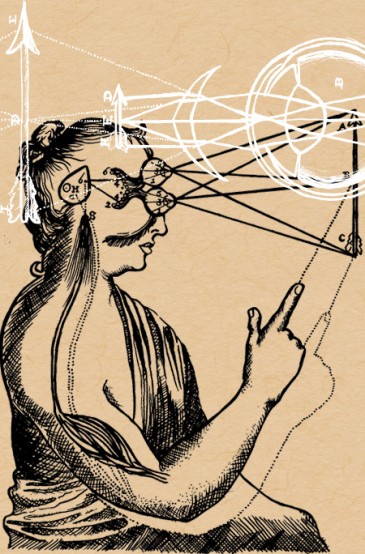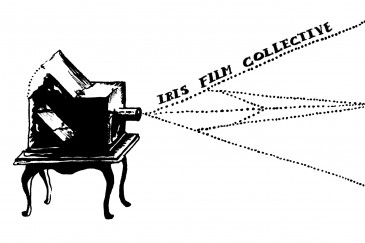
“Nowhere in its mechanical process does the camera hold either mirror or candle to nature.” Those words come from Stan Brakhage, the celebrated experimental filmmaker, whose 16mm films were screened outdoors in Falaise Park this past March. Free and open to the public, the “by brakhage” screening marked the inauguration of the Iris Film Collective’s fieldhouse residency.
The Collective, which officially began in January 2014, has hosted outdoor screenings in public parks, on sides of buildings, and on docks over the ocean.
So who are the people bringing Brakhage and other films out in the open? If you’re interested in independent and avant-garde cinema, you may know some of them from the darkrooms at Cineworks, the projection booths and program guides at the Pacific Cinématheque, and the lobbies of gone-but-not-forgotten micro-cinemas like Blinding Light!! and Edison Electric.
Eight members and one auxiliary member, this collective of artists and filmmakers is Alex Mackenzie, John Woods, Sydney Southam, Ryder White, Amanda Thompson, Lisa G Nielsen, Zoe Kirk-Gushowaty, Ariel Kirk-Gushowaty, and Simone Smith. According to the collective’s website, their “key interest” is “in ciné film — actual celluloid — at a time when this medium is shifting to a post-industry model.”
“Like film, there are a lot of things that people are turning back towards doing for themselves,” says one Iris member, Ryder White. That extra effort to get what you’re looking for isn’t uncommon amongst Vancouverites; many of us now grow our own food, brew our own beer, and make our own clothes. White and fellow member Amanda Thompson meet me at Bomber Brewing for this interview; a fitting example of this return to local artisanal rather than industrial creations.
The collective originates from a workshop, put on by current member Alex Mackenzie in early 2012, on expanded cinema. Explaining what expanded cinema entails, White says “The term cinema generally describes a 1:1 relationship with viewer-to-screen. Think of all your typical movies where you sit in the dark and view one set of images. Expanded cinema goes beyond the screen using multiple projectors or otherwise altering the space or the light. Projector performance is expanded cinema, multi-screen, or projecting on a surface that’s not flat, live elements — anything that’s beyond your typical proscenium square.”
The Iris Collective takes on the challenge of making films as artists, a much different system than the hierarchy of a major movie production. So, as an independent filmmaker, why bother to join a collective? White explains, “Even in our workflow — which is more centred around the originator, where one person is conceiving of the idea, filming it, developing it, printing it, and projecting it — there’s still a lot that we can get from communal exchange.” Fellow member Amanda Thompson adds, “In some ways it’s strength in numbers.”
Their first official year together brought plenty of experimental films into and out of Vancouver. They presented Your Neighbour’s Window Film Festival, a lo-fi presentation of short films in the backyards and alleys of Grandview-Woodlands; they toured their own films around the Gulf Islands, and hosted artists from Quebec, Germany, Australia, and the USA. At that point it became clear to the Collective that, as Thompson recalls, “There’s an appetite for what we’re doing here.”

As Iris Collective celebrated their one-year collective anniversary, they was selected by the Vancouver Board of Parks and Recreation for an artist studio residency at the Falaise Park Fieldhouse. “They have a bunch of old former care-takers’ houses in different parks around the city,” says White. This particular one is theirs until 2017.
Nestled in the southeast corner of the sloped park just off Rupert and Grandview, the Falaise Fieldhouse is a nook filled with projectors, editing tables, darkroom materials, and reels of celluloid. The kitchen window of the fieldhouse doubles as a projector screen for their public screening of films in their collections. White describes the Falaise Park fieldhouse as “a raison d’être” for the Iris Film Collective moving forward.
Only a few months into their three-year residency, the Iris Film Collective has screened films by Brakhage and works from their collection at the Falaise fieldhouse. They’ve also since hosted artists like Roger Beebe, whose work has screened at Sundance and MoMA, and Berlin-based filmmakers OJOBOCA (Anja Dornieden and Juan David Gonzalez Monroy). Most recently, Iris presented new work on B&W hand-processed 16mm by members of the collective at Art Waste in Crab Park, and hosted the Double Negative Film Collective from Montréal. In the fall, as a part of this “Collective Unconscious” series, Iris will also host collectives from Ottawa (Windows Collective) and Toronto (Loop Collective).
“I think that the emphasis on making film has become much more Do-It-Yourself,” notes Thompson. “You have to take responsibility for it now. There isn’t a lab down the street that will do everything for you. I think there’s more of an onus on the filmmaker. You have to try a little bit harder.”
Not only do the members of the Iris Film Collective take on the growing challenge of working on film in a digital age — they also choose to share it with the community through free public screenings, hands-on workshops, and talks from internationally influential artists. From now until 2017, Iris will continue building this momentum. “At the end of our residency, it should conclude with a large-scale project that involves the community in some way,” says White. “So if you live in the neighbourhood of Falaise Park and you’re reading this Discorder article, we’re coming for you.”
“We would really like to get film equipment into the hands of a lot more people,” White continues earnestly. Thompson pipes in on that note, “Or just an awareness and appreciation that film is not dead.”

